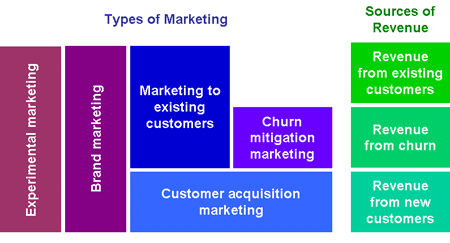Target your marketing budget to company objectives
By David Pham
Marketing budgets, especially in small and mid-sized businesses, are often arbitrarily set as either n% of planned revenue or n% over the prior year's marketing budget — without considering the objectives to be achieved by that marketing spending. Marketers can use targeted budgeting to more intelligently set their budgets based on the objectives that they are trying to achieve for the company.
Using targeted budgeting, marketers negotiate the budget by following a bottoms-up approach with specific spending targeted at specific objectives. This budgeting model makes it possible for the marketer to say, "If you add $1 million to my budget, I can accomplish this," or say, "If you take away $1 million from my budget, it will affect this area of revenue or that brand awareness objective."
Revenue sources — where do sales come from?
Before this article discusses categorizing marketing activities to align with the targeted budgeting concept, the typical revenue sources for any company should be defined. Revenue typically comes from three areas and can be easily delineated:
-
Existing customers Companies sell to existing customers through:
- Fulfillment of ongoing, long-term contracts (for example, three-year cell-phone agreements)
- Increased account penetration (for example, selling more software to more users within an organization)
-
Up-selling product or service add-ons (for example, selling premium checking accounts to holders of standard checking accounts)
-
Cross-selling of different products to existing customers (for example, selling life insurance to purchasers of automotive insurance)
-
Churn mitigation Companies try to "rescue" or mitigate churn by offering special incentives to customers that have indicated a desire to switch their service to a competitor or to cancel their service entirely. Churn mitigation revenue can be expressed in a number of ways, but it is typically thought of as the revenue from customers after they have announced their intentions to no longer use a company's service.
-
New customers New customer acquisition includes revenue from a customer that has never before purchased from a company. This can also include revenue from customers that may have purchased in the past but have not purchased from the company for a long period of time — for example, for more than two years.
Using these delineations of revenue, marketers can define specific activities to achieve revenue objectives in one or all of these areas.
Mapping marketing activities into revenue objectives
Marketing activities can be easily mapped to support these revenue sources — existing customers, churn mitigation, and new customers — in the following ways:
Experimental marketing — room to think outside the box
Not included in the aforementioned activities is the concept of setting aside a portion of the marketing budget for experimental purposes. There are some types of marketing that have never been used before, either in your industry or by your company. Ten years ago, this uncharted territory could have involved search-engine optimization. Today, it could include blogging or podcasting. What will it be tomorrow?
Portions of a budget that are set aside for experimental marketing could also be directed toward marketing opportunities that arise but weren't foreseen during the budgeting process. This might include joint marketing with new partners, marketing at new trade shows, or even marketing in new publications. Better to be ready now for the unforeseen than to have to go back to the well when an opportunity arises.
Marketing relies on flexibility for planning ahead for the unknown. This can easily be accomplished by setting aside a portion of the budget, designated for experimental purposes, with some (albeit nonzero) expectation of return.
The following figure maps the relationship among various types of marketing and their corresponding sources of revenue.

Using the targeted budgeting model in the 4-P framework
At both the strategic and tactical levels, marketers look to optimize their activities in light of product, price, place, and promotion — the 4-P framework. So far, this discussion has focused primarily on promotion, the advertising P. The targeted budgeting model can also be used to delineate the three other Ps against your revenue objectives. Each of these objectives can be line items in the targeted budgeting model. Their effect can be mapped against new, existing, or churning customers.
-
Products Revenue from new products that are introduced during the year, as well as their associated launch costs, could be split across new and existing customers, so that the marketer can properly design marketing activities and drive the associated creative concept for these activities.
-
Place This is revenue from new channels that are introduced during the year, as well as their associated launch costs. Revenue from new channels can also be mapped against new-customer acquisition and existing customer revenue. The incremental revenue that might flow through a new channel must be tempered with the potential cannibalization of revenue that otherwise would have sold through competing channels.
-
Price The targeted budgeting model can be enhanced to account for price changes that may be planned throughout the year, as well as any associated potential incremental marketing. Although not often practiced, prices for new customers can differ from prices charged to existing customers.
Go for the gold
The targeted budgeting model provides marketers with an added weapon in their arsenal to more accurately define, communicate, and defend their budgets. In this model, marketing activities are directly tied to specific revenue objectives in a way that is easily understood by the "C-Suite". Marketing budgets no longer need to be made based on a percentage of revenue or a percentage increase over the prior year, but they can be made — bottoms-up — based on how they will help the company meet specific corporate revenue objectives.






